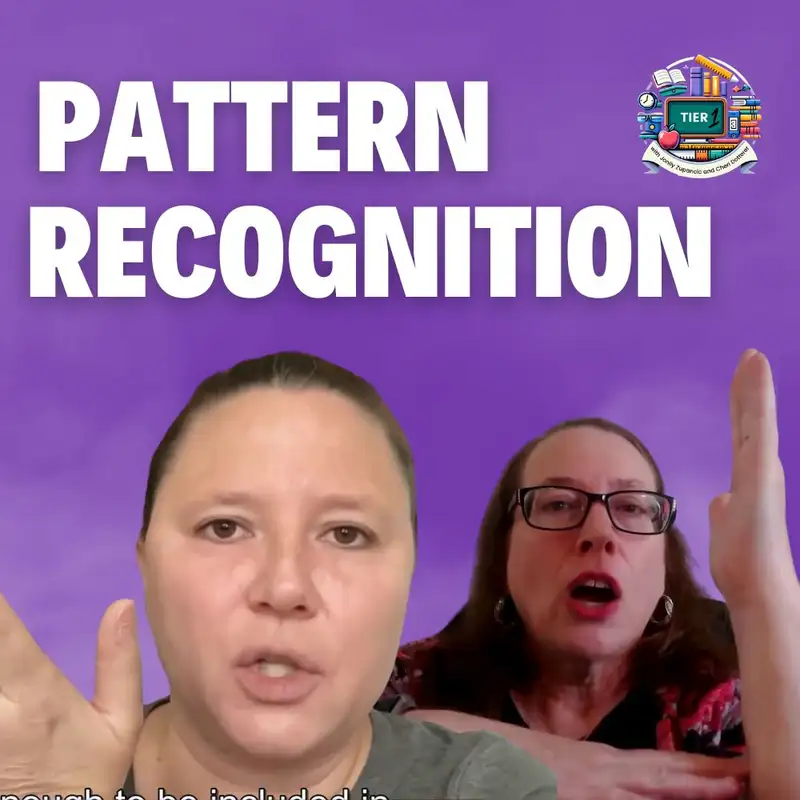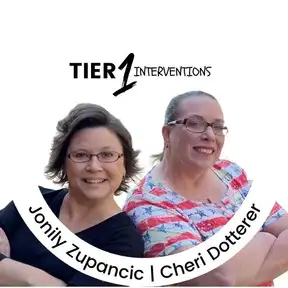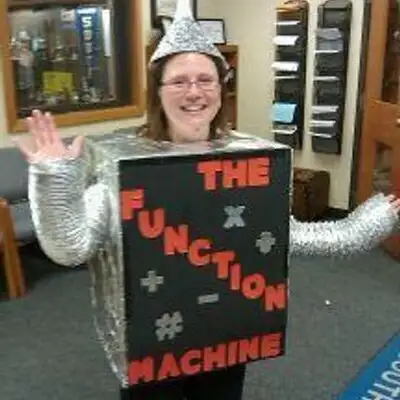
Boost School Achievement with POWERFUL Visuals: S2 E4
Speaker 1 0:00
I wrote this quote down earlier, when you first started talking about pattern recognition. Here was the sentence that Sherry said, and it was absolutely dynamic. Visuals are the foundation for interpreting one's life. Welcome everyone. This is tier one interventions podcast. I am one of your hosts. John Lee Zupancic, math specialist, and my co host is here, co author, partner in crime, all of those things. CHERI dotterer and occupational therapist and neuroscience expert. Our topic today is pattern recognition and talk about how this affects the learning of our students in school week, we
Cheri Dotterer 0:44
brought you the beginning of the discussion on pattern recognition. Let's jump back in to the discussion and see what the second stage of pattern recognition is. Sherry was talking about the clock. This is written down the left side. So on the left side that will be the right brain. This is down the right side that would be your left brain. The left brain, the parietal lobe in is mostly where that is coming from. I see brain syndrome as a result of a neurological injury. There's more potentially going on with that student that you probably didn't even think about. To pull
Speaker 1 1:37
this back to pattern recognition and moving in to launching our math task for today, I do want to say that pattern recognition, compared to all other mental abilities and capabilities, pattern recognition has the highest and strongest correlation to general IQ, general cognitive ability, because in general, IQ tests, cognitive ability tests, much of what they're assessing is pattern recognition. Analyzing how this child's brain operates is essential for brain instruction. And having said that, when we are thinking about pattern recognition, oftentimes in mathematics, we use patterns to teach the mathematics, which leaves a lot of kids out. Think about kids that say, Oh, I'm good at math, or I'm not good at math, and we're like, yeah, you're not good yet. But some of them never get good because we don't deliver it right, but those kids that have this natural knack for patterns in mathematics, they're able to then make associations and connections and access our grade level content much easier, much quicker than the kids that don't. And what happens is, we then don't improve their pattern recognition. We just give them more of it that they can't do. How do we actually extract student perspective, how their brain operates, and teach to that? That's the whole point of tier one interventions. That's the whole point of what we're doing with our math delivery model. Is giving kids access to mathematics, kids that already have access, or kids that struggle with mathematics. It's just status quo. I don't know these kids are they're going to go to Advanced Math, and these kids aren't. And some of our philosophy is we just need to be okay with that you're either an advanced math kid or you're not, and it doesn't have to be that way. If you are a non advanced math kid, kids that aren't being placed into advanced math classes, it's because you haven't had the proper instructional delivery to create a better schema and a better pattern recognition to access the advanced math courses. And we've done a lot of research on what we call the achievement formula, which is an instructional design and delivery process. And through this process, we've done a lot of work and research on what that delivery process should include, and we have found that these kids that struggle with mathematics are now scoring high enough to be included in advanced math classes, and this is a breakthrough. We found through data that we are breaking the bell curve when 50th percentile is average, our cohorts of kids are not below the 70th percentile in our achievement results when we have students a cohort of students that maybe only 25 of them passed the state test or end of course exam the year before. We use this model for six months, all of a sudden, 60% of them are passing. 70% of them passing. I have a school client that I've worked with for the past two years, and. And their fourth graders, and typically passing for fourth graders, I'm in Ohio, in the state of Ohio, is anywhere from 25% passing to 65% passing, sometimes 70% passing. So this group of fourth graders, all of the fourth graders of that cohort from last year's class, 84% of them passed. So by analyzing the neuroscience in the brain and how the brain learns mathematics, we are skyrocketing math scores. So in your area, if you're listening to this and you have dismal math scores, pay attention, because this is absolutely transcending, transforming, escalating and scaling the math achievement in these districts that are using this. Any other thoughts points that you want to make, Cheri, before we jump into the task that we're going to launch today to uncover how we can use a single task to improve all of these things that we've talked about,
Cheri Dotterer 6:01
sure, there's two more sections to pattern recognition, the first part we just talked about, the second part neurologically. This is coming from a neurological standpoint. The second part is reinforcement. With reinforcement, we're using features and classifications to help students sort in their brain what they're looking at. How many what is the placement? Where is the placement of that diagonal on the page? How many diagonals do we have? What colors are we going to sort them or group them. We've talked about a square. What happens here? Kids don't make that connection, and it's a square with two more sides to it. To make a Rubik's cube, we change the constancy, and we change it to a dark and they get totally confused. Go back to the very first area where constancy is an issue, or constancy is part of that form and that topology. If we change the the form by changing the constancy of it, by adding some dimension to it, they get lost. Keep that in mind with your students. How about this one? Kids don't understand what this is. Oh, now we've just added a totally different dimension. It's not even mathematics. I'm going to breeze right into the recall. Before
Speaker 1 7:36
you do, I want to make a couple other connections with reinforcement and classification. One of them is a funny story. I just thought of when you were talking, and it makes me crazy every time I go to the grocery store, but pin that for just a moment. But when you're looked at all of those stimulus that Sherry created, there was no noise, there were not a lot of words, there were not a lot of questions that made you solve or answer or put you on the spot. That is a beautiful example of a stimulus. That's how we need to teach our content, not only in mathematics, but in every area. Is with a stimulus that a lot of the noises move, not the noise we hear, but the words, the symbols, the question, things that are going to force answer, getting and solving, because that creates high anxiety, and then the brain is going to shut down and have no access to learning. The way Sherry just showed those stimulus allow kids to take bigger risks. It puts everybody on the level playing field. If you notice what she was saying, what do you see? What do you notice? Tell me about these things. That is the first step in teaching any lesson that we teach thinking about classification and thinking about just sorting and understanding the world around us and how we connect things together, is exactly pattern recognition. Pattern Recognition is all about taking all of the information I already know and connecting it to other things the next time you go to the grocery store, if you still have grocery baggers at the end of the checkout,
Cheri Dotterer 9:06
makes me nuts. I
Speaker 1 9:07
can tell how a person's brain operates by the way they bag my groceries. Okay, like this is insane. I want to do a lesson with all grocery baggers on pattern recognition, because what happens is I've got two packages of meat. They put one package of meat in a bag with my klondikes, and then the other package of meat in a bag with my pop tarts. That's for me. Sarah says in the comments she fell in love with Audi because she can bag her own grocery I step in at the Kroger and I'm like, You know what? I'm particular. Because here's the thing, it's not that I'm particular and I'm type A and I'm a control freak. When I get home, I put the groceries away, what you're doing with your lack of pattern recognition and your lack of understanding classifying you're making it more difficult and causing me more. Time to put my groceries away to see there's an effect on the lack of these skills. Great connection and
Cheri Dotterer 10:10
great way to advance what we're doing to business.
Speaker 1 10:16
Yeah, love it. And then, what's our last category? Sherry, and then we'll jump into our math task.
Cheri Dotterer 10:20
Sure it is recall. The very first thing that your brain does, it recognizes it makes connections to the rest of our world. Reinforcement is where we sort it and we group it together. And then the last part is recall. And one of the things that I want to stress here about recall is we need to forget things and then bring them back into our consciousness. That is part of what recall is. We need to retrieve things. We need to space out with our students, especially because they're in that learning process. We need to space out what they're learning. We need to bring, excuse me, we need to bring it back and interleaving. I'm going to leave Jonna Lee define that in just a moment, but before she does, I want to ask you a question. What do you see? I see the animal cell. Okay. Amy, you're giving us the look. What do you see? I was thinking that one of it looks like a scrambled egg. Okay,
Speaker 1 11:38
that is a part like a not a scrambled egg, but
Cheri Dotterer 11:41
like a cracked egg in a pan. Yeah, a Dippy egg. Yes. Janet, how about you sell the animal cell first? But then I was like, Wait, let
Unknown Speaker 11:52
me go creative, and I'm making soup for lunch. So
Cheri Dotterer 11:54
I was like, I seen soup. I love it. I love it. See how we found different perspective, and we used recall, we used recognition, and we used reinforcement. When I was looking for the something complex on Canva to create this, it was under the cell, but I see where it can be soup egg or a cell. For those of you listening, go to to our YouTube channel at tier one interventions podcast, so you can see what Sherry is putting up on the screen. Is it eggs and bacon or or is it a cell? Well, I love notes here
Speaker 1 12:37
Sherry You mentioned earlier, way early on, when you first started talking about, I wrote this quote down earlier, when you first started talking about pattern recognition. Here was the sentence that Sherry said, and it was absolutely dynamic. Visuals
Cheri Dotterer 12:52
are the foundation
Speaker 1 12:57
for interpreting one's life.
Cheri Dotterer 13:01
Visuals are the foundation
Speaker 1 13:05
for interpreting one's life. How often, especially at intermediate and secondary mathematics, do we connect and associate and teach and facilitate with
Cheri Dotterer 13:21
visuals rather than the symbols,
Speaker 1 13:25
not very often, because we as the instructor and the teacher don't even know what visuals match the mathematical notations and symbols. That is the entire premise of tier one interventions is to make math accessible to everyone through these neuroscience techniques. Today's problem that we are going to dig deep in is a historical math problem. You may have seen it before. You may have never seen it,
Cheri Dotterer 13:59
but it is the locker problem I have. I have one more reinforcement before you get started on the locker problem. Oh, perfect.
Unknown Speaker 14:07
Yeah. Let's see. Okay,
Cheri Dotterer 14:11
this isn't necessarily a what do you see? This is another point I want to make about recall and recognition. It is, what do you feel? What do you feel when you see this picture versus this picture? There's a difference in the feeling. Wasn't there? I'm going to ask you, in your hearts, to think about what the student is feeling. What is that trigger that's happening inside their autonomic nervous system that's triggering the fear response. The fear response is going to negate any chance of us moving forward in learning. It's going. To stop learning. So I'm going to do a summary. If anybody wants to take a screenshot of this. I've added three more words on to the bottom of this diagram,
Speaker 1 15:13
belonging, autonomy and mastery. When we are incorporating good pattern recognition into our curriculum, we are creating a sense of belonging, autonomy and mastery. Belonging meaning one of the largest factors for student and human motivation. If you want to increase intrinsic motivation for kids, it's to give them a sense of belonging. The way to do that in mathematics or in any content, is through the stimulus and gaining their perspective and celebrating their perspective. Daniel Pink talks a lot about these things in his book, drive. What drives human behavior and motivation? The other factor is autonomy. Autonomy means I have some choice, just like a toddler, I'm not going to let them pick out anything to wear in the morning, but look, you can wear this or this. We have to have choice, but we have to have limited choice. So those factors are heavily researched. Number one by Daniel Pink on what drives human behavior, if we think about mathematical practices, and we think about habits of mind, and we're like, oh, these kids just have no perseverance. It's because we're not giving them the experience necessary for them to persevere. There's nothing that they have a desire to persevere that is not their fault. It is our fault as we jump into our task of the day, the locker problem. I want you to think about that entire chart, all of those stages, all of those components, and try to make those connections to how we teach mathematics, typical, traditional mathematics instruction, typical, traditional mathematics instruction elicits that fear response every day with students, they don't get it. We're harming them every day. Now we can be like, Yeah, but I showed them six times, or we get the email from a parent, the kid took home the homework, and the parent is they have no clue, and the teachers, oh my gosh. We went through three examples. It didn't work. It didn't work. That's their perspective. That's the student perspective. And perception is their reality.
Cheri Dotterer 17:40
That is schema,
Speaker 1 17:42
and we can't change that by just saying I did my job. Now they need to do theirs. That's not how teaching works. All right, Sherry, give us an unveiling of what you have been working so hard on, and what we have to offer people. It's just fun. Yes.
Cheri Dotterer 18:02
So this came totally out of left field and totally not in my thought process, until I got something on Facebook one night that said, why don't you do this? And I'm like, but I can't there's nothing we have to offer we do. So the first module that we recorded was called the pizza problem. What I've done is I've taken the pizza problem and I've turned it into one page, quick, quick start guides that you can just take the ideas and I'm working on all of them. Okay, that's not it. That's not everything. I've also had to incorporate some ideas for writing. There's some ideas for writing, and on the back of that, there is a checklist on what to look for when you've got kids who have writing struggle, where the core issues might be. I do have a welcome thing. We've also been, I'm not quite ready for this one to go out yet, but we've also been looking at how to use tell me about so tell me about currently has a little two page. I think I have to work on that some more. But that's not all. We have some presents for you. Inside this little package is a little gift for you. We have gifts like this for you. Everybody needs stickers, right? One of them says, Be kind. Where are they? Here they are. Can you read it? Can you back it up a little bit? Maybe, because it's the wrong way. There we go. I. Am brilliant. So this goes along with Where'd I put it? Why do short pencils help our kids? If the kiddo you gave a kiddo a pencil that says, I am brilliant, who's struggling, what does that tell them? Locker problem magnets. Sarah, you would appreciate these. I'm not so sure Krista would, but Sarah, you definitely could use a scrunchie or two. Let's see. We found this amazing game. Found this amazing game. It has all of these colored stickers that are made out of squares, and there's a game that goes with it. We give you one copy, and we tell you how to find some for the rest of your classroom, the teacher survival kit, so you can use this bag for whatever you want. Plus, just for the holidays, we got some socks for you because you always want to call a warm up by the fire, right? And I'm wearing them along with a bangle. And we have, we're, I'm still working on getting the right necklace to go with it, but we're working on that. So what is this? This is a buy one, get one. Buy one, gift, one offer for you,
Jonily 21:22
the whole premise is, teachers are going through a lot right now. We're struggling. Sarah, you had the question of, what are the best adaptable resources? So we've combined that question for each of the tasks, like, what are the best adaptable resources for each of the tasks? We have a quick start guide. So it's all based on the tasks, but it's also based on teachers need to just take care of themselves. So there's a combination of this, and it's called 3d 3d the three disabilities, dyslexia, dysgraphia, dyscalculia, and it's relief in 3d so that we can get some relief for our struggling students, and then just fun relief for us, like good fun gift for us,
Cheri Dotterer 22:10
a brand new store. This is brand new. You guys are the first people to see it. I have a lot
Speaker 1 22:14
in store, a lot coming up, a lot to unveil. It's going to be an amazing year, not only with the tier one, but also with all of these additional things that we will have to offer. And
Cheri Dotterer 22:25
join us in two weeks to learn more about the locker problem coming up next week, we're going to be talking about impact learning how.
Transcribed by https://otter.ai
Episode Video
Creators and Guests


